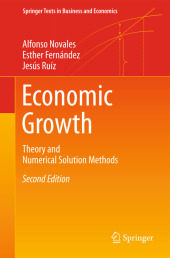 Neuerscheinungen 2014Stand: 2020-02-01 |
Schnellsuche
ISBN/Stichwort/Autor
|
Herderstraße 10
10625 Berlin
Tel.: 030 315 714 16
Fax 030 315 714 14
info@buchspektrum.de |

Esther Fernández, Alfonso Novales, Jesús Ruíz
(Beteiligte)
Economic Growth
Theory and Numerical Solution Methods
2nd ed. 2014. xiii, 558 S. 20 SW-Abb. 235 mm
Verlag/Jahr: SPRINGER, BERLIN 2014
ISBN: 3-642-54949-7 (3642549497)
Neue ISBN: 978-3-642-54949-6 (9783642549496)
Preis und Lieferzeit: Bitte klicken
This book integrates the analysis of theoretical models of economic growth and computational methods to produce numerical solutions. It features a detailed discussion of economic policy issues.
This is a book on deterministic and stochastic Growth Theory and the computational methods needed to produce numerical solutions. Exogenous and endogenous growth models are thoroughly reviewed. Special attention is paid to the use of these models for fiscal and monetary policy analysis. Modern Business Cycle Theory, the New Keynesian Macroeconomics, the class of Dynamic Stochastic General Equilibrium models, can be all considered as special cases of models of economic growth, and they can be analyzed by the theoretical and numerical procedures provided in the textbook.
Analytical discussions are presented in full detail. The book is self contained and it is designed so that the student advances in the theoretical and the computational issues in parallel. EXCEL and Matlab files are provided on an accompanying website (see Preface to the Second Edition) to illustrate theoretical results as well as to simulate the effects of economic policy interventions. The structure of these program files is described in "Numerical exercise"-type of sections, where the output of these programs is also interpreted. The second edition corrects a few typographical errors and improves some notation.
Introduction.- The Neoclassical Growth Model Under a Constant Savings Rate.- Optimal Growth. Continuous Time Analysis.- Optimal Growth. Discrete Time Analysis.- Numerical Solution Methods.- Endogenous Growth Models.- Additional Endogenous Growth Models.- Growth in Monetary Economies: Steady-State Analysis of Monetary Policy.- Transitional Dynamics in Monetary Economies: Numerical Solutions.- Mathematical Appendix.


